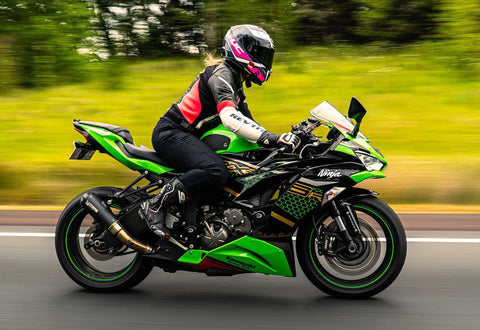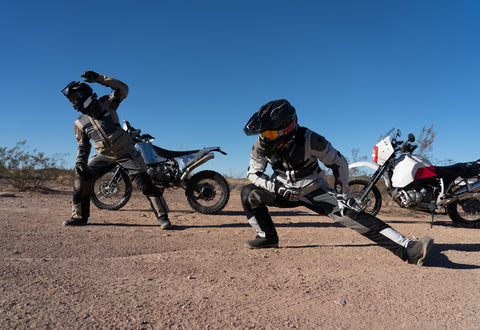FAQ Series: How Should a Motorcycle Jacket Fit?
By the Motogear Team
Have you decided leather is your jam? Or perhaps you prefer the idea of a fully vented textile jacket on these scorching summer days.
Our previous blog post was all about the different materials and styles of motorcycle jackets available in New Zealand. Now we are going to cover how to measure for the size and fit of a new motorcycle jacket. No matter what style or material you prefer, we’ll help you find the perfect fit for your body and your riding requirements.
FAQ 1:
“How should a motorcycle jacket fit?”
Just like the Goldilocks fairy-tale, a motorcycle jacket should fit ‘just right’.
Too loose, and it can become a non-aerodynamic wind sail while you ride. Not only will this cause drag and affect weatherproofing abilities, but it will also be unsafe in a crash. Nobody wants their motorcycle armour twisting out of place, or their jacket to ride up and expose skin during a fall.
A jacket that is too tight is also bad. Being able to move comfortably and freely on the bike is a safety factor. Even form-fitting leather race jackets that appear to be skin tight, need to allow free movement during riding. Consider the flexibility needed to manoeuvre into the full tuck position on a sportsbike.
Of course, we are all built differently, so finding a motorcycle jacket to fit snugly and ‘just right’ can sometimes prove difficult. Some styles may fit your body better than others. Different brands and cuts within these styles will also have their own unique differences.
Slim Fit / European Fit:
Usually feature a tapered waist, and narrow shoulder, torso and arm circumference.
 Image credit: REV'IT!
Image credit: REV'IT!
Regular Fit / American Fit:
Usually feature a wider waist, shoulder, and arm circumference.
 Image credit: Speed and Strength for Motogear
Image credit: Speed and Strength for Motogear
Race Fit:
Usually feature a slim silhouette for aerodynamics, pre-curved arms for aggressive riding positions, shorter arm length for longer gauntlet race gloves, and a shorter waist for connecting to race pants.

Image credit: REV'IT!
As previously mentioned, some brands also feature different cuts within their product line. Motodry features ‘Stout’ sizing in its larger sizes (see their Rally 2 jackets), and Scott features 'D-Sizing' specifically designed for riders with broad chests and shoulders (see their waterproof shell Ergonomic jacket).
FAQ 2:
“How do I measure for a motorcycle jacket?”
Motorcycle apparel can be sized in two different ways: alpha sizing (eg M, L, XL) or numerical sizing (eg 48, 50, 52). If you are trying on a jacket in a physical shop, you can start from the size of shirt you would usually wear and work up or down from there.
Finding the perfect jacket online requires a slightly different method, as shown by the 6 steps below. Taking the time to write down your measurements may seem like a hassle initially. However, doing so will give you access to a wider range of motorcycle jacket options online.
Step 1: Brand Size Chart
Start with the sizing guide of the motorcycle jacket brand you are looking at. This will show you HOW to measure, what metrics to measure with, and any unique fitments to be aware of (eg, if the jacket is a stout fit).
It's important to know that some brands use different points to measure between, like sleeve length. That's why it's crucial to measure against the brand's sizing guidelines from the outset.
Step 2: Measuring Tape
Use a tailors measuring tape to find the three or four measurements required. This part will be easier with a friend to take your measurements for you, but you can do it alone too.
Measure yourself while standing up straight, breathing normally, and wearing the type of clothing you plan to wear under the jacket - make sure to take the puffer jacket off before starting! And try to have the tape firm, but not restrictively tight, on any area you are measuring.
 Image credit: rawpixel.com
Image credit: rawpixel.com
Step 3: Chest/Bust Measurements
Wrap the tape measure around your back and chest at nipple height. Breathe normally when measuring and don't add extra centimeters for a back protector. It usually doesn't affect how your jacket fits.

Image credit: Motogear
Step 4: Arm Measurements
Arm measurements are either taken as a straight line from the nape of neck and down over the shoulder and elbow to the wrist, or as a straight line down from the shoulder edge to the wrist. The brand guidelines will either show you which measurement technique to use via a diagram, or you will be able to gauge this by their numeric arm measurements:
• If their arms are listed in the 80cm range (mens sizing), it means the measurement should be from the nape of neck, down over the shoulder and elbow to the wrist (see left side of diagram, below).
• If the arms are listed in the 50cm range (mens sizing), it means the measurement should be taken from the shoulder edge to the wrist (see right side of diagram, below).
Remember that race jackets have shorter sleeves than regular jackets. This is because they are meant to be worn with longer gauntlet race gloves.

Image credit: Motogear
Step 5: Waist Measurements
Waist measurements for jackets are not the same waist measurements needed for pants size, and are often not required by brands because of jacket adjustability.
However, if it is needed, take the measurement from around your lower torso approximately 2cm above your belly button.

Image credit: Motogear
Step 6: Neck Measurements
Neck circumference measurements are rarer still, as most motorcycle jacket collars have some adjustability built in. However, if needed, wrap the tape measure around your neck at the level the collar will normally rest.
Be sure to have it comfortably taut, and not restricting your breathing or neck movement in any way.

Image credit: Motogear
Key Areas To Pay Attention To
Jacket Length:
Motorcycle jackets are intended to sit shorter on your body than regular fashion jackets. You don’t want them bunching up around your seat when riding (catching and pooling all those raindrops around your nether regions!), or dangling towards your driveline or engine components.
Depending on the style of motorcycle jacket, they will either be designed to hug your waistband, or to rest on your upper thighs when riding.

Image credit: @chaotic.blonde for Motogear
Sleeve Length:
This is an important measurement to get right. You don’t want long sleeves bunched around your wrists and grips when riding, and you also don’t want short sleeves exposing your naked wrists to the wind and the road.
You need to consider the style of motorcycle glove you will be wearing as well. Longer gauntlet gloves will help keep your skin protected if you have a shorter arm length (like on race style or café-racer style jackets), and shorter gauntlet gloves reduce bulkiness if you have a longer touring jacket sleeve with wrist adjustments.
Armour:
One of the most serious aspects to consider is that the jacket armour is sitting correctly on your body.
Elbow armour should cover your elbow area and not be too loose to spin or slide around your arm. Shoulder armour should curve over your shoulder area with minimal movement, and back protection shouldn’t ride up to hit the back of your helmet when you are in your riding position.
Sometimes motorcycle jackets come with armour adjustment tabs or pockets to help fit the armour to your body shape, especially if they include removeable liners. Be sure to test these adjustment options if they are available.
Shoulders and Torso:
You want a snug fit in these areas without any restriction of movement.
If the jacket has one or two inner liners, the jacket should be a secure and comfortable fit no matter if the liners are in or out. Most textile jackets will have adjustment tabs just for this occasion – again, be sure to test these options out.
Also consider what clothing you will wear under the jacket. Wearing multiple thin layers is usually a better option than wearing one bulky jersey underneath. If you end up removing the bulky jersey, your jacket may suddenly feel a whole size too large!
A note on leather: depending on the grade of leather, the lining/s, and how often it is worn, a leather motorcycle jacket may stretch or ‘give’ bit in the torso area (±5%). However, the structural elements of the jacket, such as the armour positioning, the shoulder width, and the arm circumference, won’t change.

Image credit: Charles Jordan for Motogear
Fine-Tuning For A Perfect Fit
Just like you may spend time mulling over the many aftermarket accessories available for your bike, spending the time to ensure you have correctly fitting motorcycle apparel is a must. Consider the following questions to fine-tune your motorcycle jacket fit :
1. What is your riding position? You don’t want to expose your lower back if the jacket is too short for a sportsbike tuck.
2. What adjustability features does the jacket have? The more zippers, straps and tags it has, the more chance it will fit to your body.
3. Does it have removable liners? If so, ensure the jacket fits you correctly in all liner modes.
4. Can all the closures be closed properly? Any that can’t be closed will affect the weatherproofing capabilities of the jacket.
5. How does the jacket fit with your other riding apparel? Does it interact well with your helmet, gloves, pants, and backpack?
6. Do you have a full range of motion whilst wearing the motorcycle jacket? Can you twist, turn, lean, and reach without restriction or the jacket riding up?

Image credit: REV'IT!
Uh oh...
Occasionally, you may realise your newly purchased motorcycle jacket doesn’t suit your body or riding style after considering these points.
Of course, whether purchasing any consumer good instore or online, it is good to familiarise yourself with the returns and exchange policy of the retailer. A good rule of thumb is to keep all tags, bags, and proof of purchase intact, while you try it for size around your house. Do not test ride it on your motorcycle before determining it is the wrong fit, as retailers do not usually accept returns once items are used – even if it was just for a quick blat around the block!
We are fortunate to work with a great range of experienced retailers throughout New Zealand, who will help you online or in person, to find the best motorcycle jacket fit for your needs.
In Summary:
It's crucial to make sure your motorcycle jacket fits well, no matter what style you pick. That's the most important thing to consider. Riding comfortably helps you to ride safely – and that has to be the ultimate goal of every ride.



